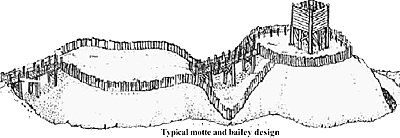 The year of 1066 AD marked the end of the Anglo-Saxon rule of England when forces under the
command of Duke William of Normandy accomplished the last successful invasion of England. The Norman forces landed at Pevensey on 28 September, 1066, and immediately fortified the town with no opposition by erecting a motte and bailey castle for defense. The Norman forces then marched to Hastings, and, again facing no opposition, erected another castle while the remaining Norman forces disembarked from their ships in the harbor.
The year of 1066 AD marked the end of the Anglo-Saxon rule of England when forces under the
command of Duke William of Normandy accomplished the last successful invasion of England. The Norman forces landed at Pevensey on 28 September, 1066, and immediately fortified the town with no opposition by erecting a motte and bailey castle for defense. The Norman forces then marched to Hastings, and, again facing no opposition, erected another castle while the remaining Norman forces disembarked from their ships in the harbor.
It was outside the small village of present day Battle, a few miles north of Hastings, where the Norman forces defeated the Anglo-Saxon army or fyrd led by King Harold on 14 October, 1066, in a day long battle. While the Battle of Hastings was decisive in the sense that most of the Anglo-Saxon leadership was killed, it was not the decisive factor for Duke Williamís consequential conquest and subjugation of Anglo-Saxon England. The pre-eminent reason for the Norman Conquest of England was their employment of the castle, a relatively new military technology that had been developed on the European mainland. Duke William of Normandy had utilized the castle to his advantage to consolidate his hold over his Dukedom and surrounding territories. It was through the utilization of castles that he finally gained a permanent hold on Normandy against his warring neighbors and rebellious nobles, and spread his influence to adjoining territories.
Upon arriving at the age of majority William took his dukedom and constructed a large castle at his ducal seat of power in Caen. After consolidating his power, he had all unauthorized castles in his Duchy either destroyed or brought under his control with a ducal writ prohibiting castles without his authorization. Duke William formalized this prohibition on unauthorized castle building in 1061 with ďThe Customs of the Duchy of NormandyĒ forbidding unlicensed castles. Duke William, by controlling the building of castles in his zone of influence and control, also dictated the style of castles being constructed as well as ensuring their being a device to further his domination of whatever territory it commanded.
 Typical motte and bailey design
Typical motte and bailey design
It was through the construction of the motte-and-bailey castle that allowed William the Conqueror to subjugate England to Norman rule after approximately twenty years of struggle. The motte-and-bailey castle is a simple fortification constructed of an earthen mound with a tower on top of it and a wooden wall surrounding the entire area.
Williamís construction and placement of castles in England to control the countryside can be compared to Alfred the Greatís genius in the utilization of the Shire and Hundred military systems in retaking England from the Viking invaders who occupied the country a few centuries earlier. Both of these great leaders saw a new military technology and used it against an enemy who had no way of initially countering it.
The first action undertaken by the Norman forces upon landing at Pevensey was to construct a motte-and-bailey castle to secure their control of the village and the surrounding territory. This castle provided the Norman forces with a defensive work to fall back upon should they encounter strong Anglo-Saxon forces before the rest of their forces could be landed from their waiting ships. It would also serve as a refuge.
If they were defeated in battle and had to retreat, they had a defensive work to fall back upon until help arrived. The lack of opposition to their initial landing allowed the Norman forces to march on Hastings and take the city and harbor without difficulty. Again we find that Williamís first priority was the construction of yet another castle to provide his forces with a secure base of operations.
Williamís employment of the castle as both a defensive and offensive device was forward-thinking in the sense that a small number of men-at-arms could successfully hold out in a well-provisioned castle for an extended period of time against a numerically superior force. Exploited in the offensive, the castle provided the Norman forces with a secure base from which to conduct sally operations in hostile territory and then be able to retrograde (retreat) to the fortress walls if they met heavy opposition that they could not successfully oppose. Thus, a review of the battles, the construction and placement of castles, and their importance as a defensive position, place of refuge, and offensive base leads to the conclusion that castles are the primary factors that enabled William the Conqueror to conquer Anglo-Saxon England.
More Role of Castles in William the Conqueror's Victory
-
Introduction
Opposing Forces: Anglo-Saxon and Norman
Battle Of Hastings
Fortifications and Castles in England
Post Hastings Conquest
1067-70, Williamís Kingdom in Peril
Conclusion, Appendix, and References
Back to Cry Havoc #34 Table of Contents
Back to Cry Havoc List of Issues
Back to MagWeb Master Magazine List
© Copyright 2001 by David W. Tschanz.
This article appears in MagWeb (Magazine Web) on the Internet World Wide Web. Other military history articles and gaming articles are available at http://www.magweb.com